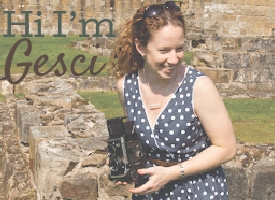Kilmartin Glen is a beautiful area in Argyll known for its significant prehistoric monuments. On our way into the village we stopped first at a more "modern" site- Carnasserie Castle. The castle sits up a steep hill, but we were lucky enough to catch a lull in the rain when we headed up.
The castle was built in the 1560s as the home of John Carswell, the first Protestant bishop of the Isles, who is also known for translating the first book printed in Gaelic.
Carnasserie is actually a pretty cool ruin, which surprised us since there's no charge to get in- it's maintained by Historic Scotland, but usually the free ruins are kind of... ruined. You can climb this tower and see amazing views of Argyll... except when it's overcast and rainy, although the view we got wasn't too bad.
The castle is considered to be an example of the transition in architecture from fortified castles used primarily for defense to finely detailed houses used primarily as dwellings. This carving over the entrance includes the arms of the fifth Earl of Argyll.
You can still see a lot of the details around the castle, like this ornate fireplace.
The view from the tower. Told you, not bad!
Our next stop was to see some of the standing stones of Kilmartin Glen. This particular set is called the Nether Largie Standing Stones.
See prehistoric, mysterious monuments; play some rugby. Oh, and there's a flock of sheep in this field, too!
More Nether Largie Stones. These were on the way over to the stones below...
The Temple Wood Stone Circles. Two stones circles, the earliest incarnation dating around 5000 years ago. Click on the picture and see the spiral carving on the second to right front stone.
One of the most interesting sites in Kilmartin Glen is the linear cemetery. Five cairns, mostly Bronze age but one dating to Neolithic times, are perfectly aligned over almost three miles. We were able to see most of them, but unfortunately the weather deterred us from exploring them on foot.
Kilmartin Church houses some of the oldest carved graveslabs in Scotland. Some of the oldest are protected in a tiny stone building in the church cemetery, which we were able to go into.
These graveslabs date from the 1300s to the 1700s, and it's impressive how some of the details have remained. After this the weather got the best of us, so we headed back into Oban for dinner.


























No comments:
Post a Comment
Thanks so much for stopping by! I can't wait to read your comment!